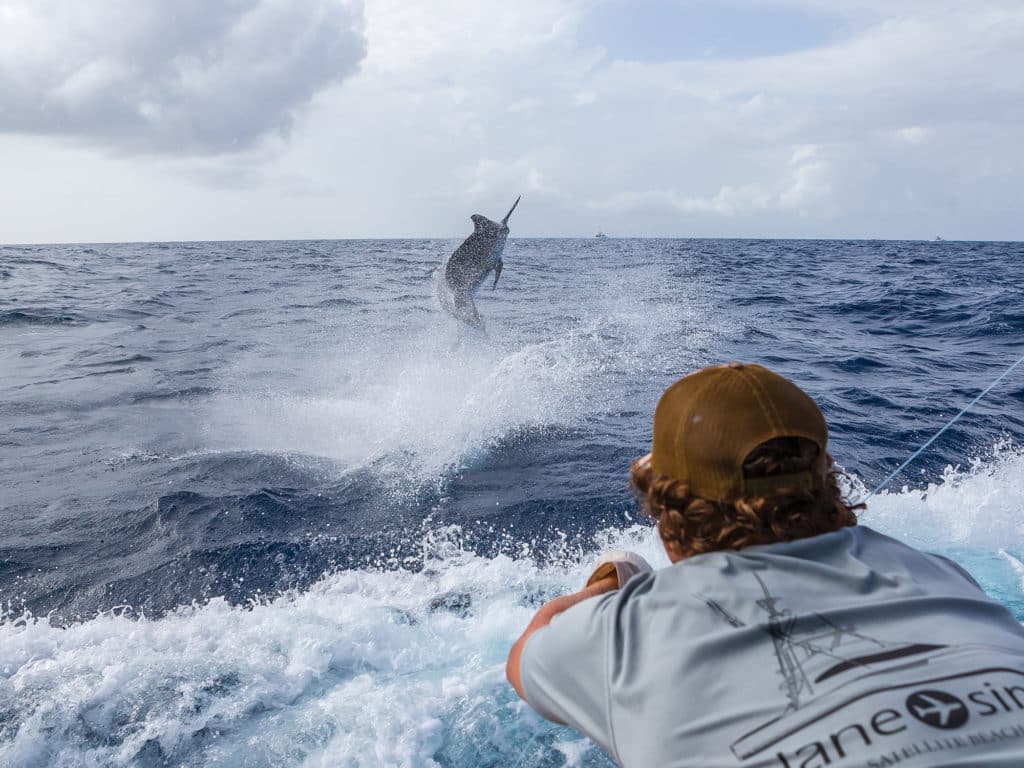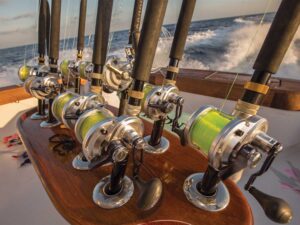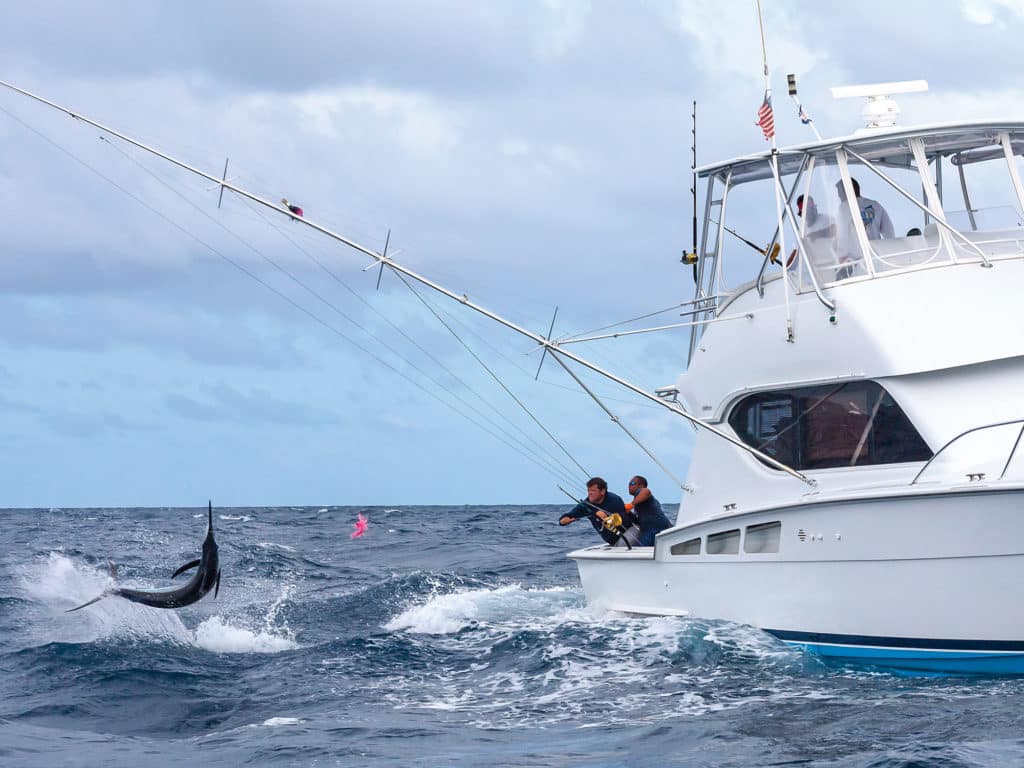
Ever since my early teenage years, I have been on a mission to learn as much as I possibly can about catching blue marlin. This objective has led me to meet and fish with some of the world’s best captains and crews, in addition to fishing in some of the world’s hottest fisheries. It has also given me the privilege to see and learn the different techniques that crews use to target and capture fish. However, one technique stands above all others, and that is trolling a spread of heavy-tackle lures.
Lure fishing has turned into my absolute passion: As a captain, I can tell you that setting up a spread of lures and then finding and fooling a fish into attacking a lure is second to none in my book. Unfortunately, this method gets branded “drag and snag” by many, but I strongly feel this is not the case. I have come to learn that a skilled lure fisherman can use techniques that are far from “drag and snag” to get good results offshore. We proved this on a recent trip to Cape Verde where we managed to raise 60 fish, got 50 of them to bite and released a respectable 36 of them — all on lures. It’s not only about how you rig and present your lures so that they optimally perform, it encompasses the way the angler fights the fish and how the skipper drives the boat too.
Setting Up My Spread
I like to fish a basic spread of four lures and two large teasers. I will generally pull two angle-faced lures and two cup-faced lures fished in pairs, with two lures — one of each style — on the third wave and two lures on the fifth wave of my wake, with the two large teasers in short. The use of the large teasers gives me the best chance of raising large marlin into my spread; of all the blues I have raised, most of the truly big ones come into the spread by trying to eat something large.
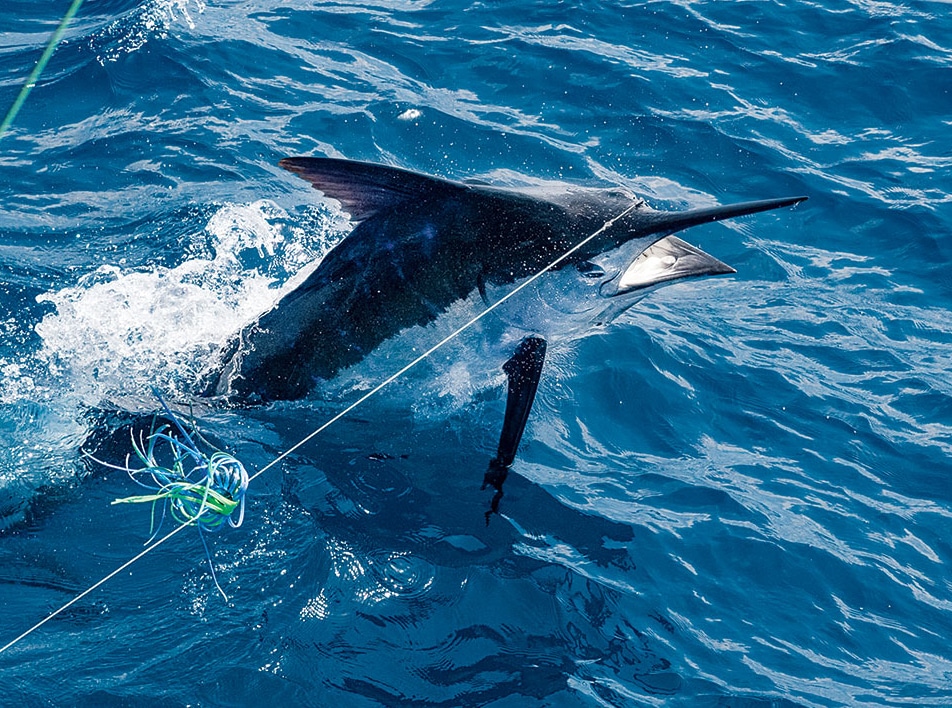
When I rig my lures, I rig for performance over hookup rate because a well-presented lure will attract more bites, allowing me more chances of actually putting sharp hooks into fish. Therefore, all my angle-faced lures are rigged with two hooks in a 180-degree orientation with a swinging back hook. All my cup-faced lures are rigged with a single swinging rig, with the hook as far back in the skirt as legally possible — this is why I really like lures with long skirts.
The Pointy End
When it comes to hook selection, I like to use a closed-gape hook, and most of my lures are rigged with a 9/0 or 11/0 hook-set, depending on the size of the lure. It goes without saying, but I like the hooks to be razor sharp, with a long point and small barb. I have not noticed any difference in hookup rates between the two different rigs I pull.
I like to run the entire spread from the riggers, including the teasers. This gets the leaders up as high as possible, so there is as little leader in the water as possible. This keeps the lures running in the clear water outside the wake, and it gives the fish the best chance of eating only the lure, rather than eating the leader in front of the lure as well. The release system I prefer to use for my riggers is a Dacron loop into a Black’s clip attached directly to the halyard. This creates a natural drop-back, which I feel allows the fish to turn away before any real drag pressure is applied to the fish.
Drag Management and Boat Driving
After getting a bite, I like the angler to keep the drag on the light side. When fishing heavy tackle, my bite drag is set at 10 to 12 pounds, with a light release from the outrigger clip. As the captain, I will bring the boat to a relatively quick stop, and I will get my angler to keep the same amount of bite-drag pressure, if not back off a little. All I am trying to do is stay connected to the fish while the deck is cleared. No amount of drag is going to stop a rampaging blue marlin — all it is going to do is break something.
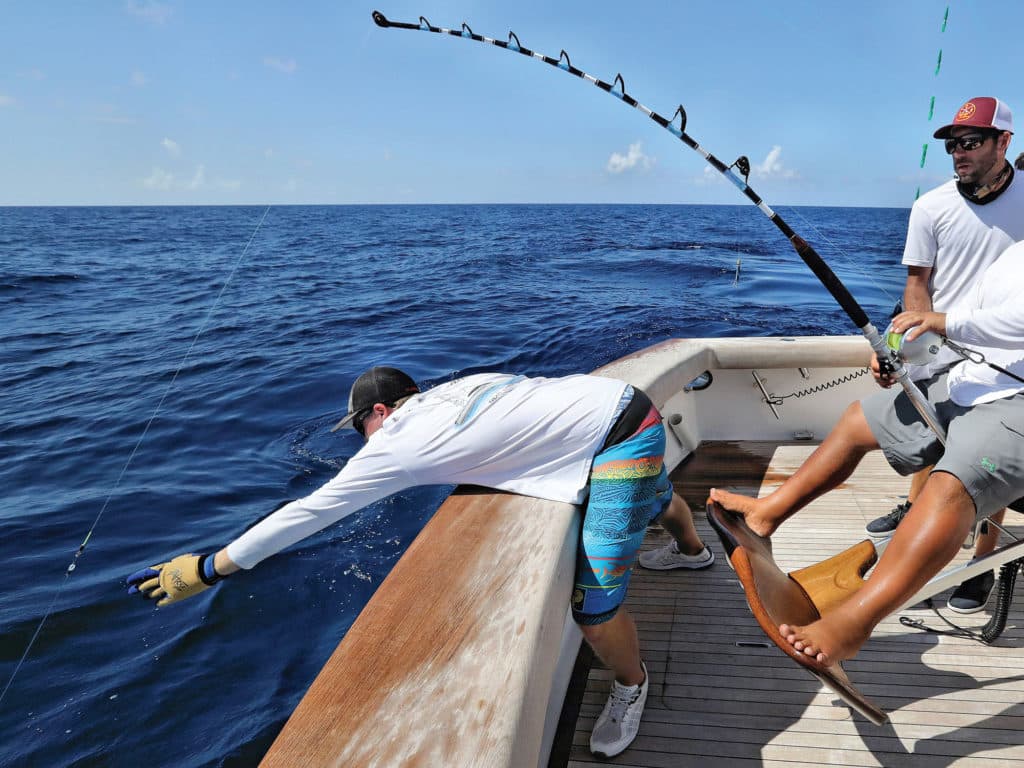
While the crew clears the deck, I begin to either back down after the fish or start to turn and chase the fish. The decision is dependent on how much line the fish is taking. My goal at this point of the fight is to try to minimize the amount of line lost with some aggressive boat handling.
With the fish hooked, the captain and the angler must perform a balancing act to ensure things work. I constantly try to keep the lure behind the fish; if the fish is bill wrapped, this will give the hook the best chance of staying connected and not sliding off the bill. Therefore, I drive the boat more toward the fish rather than directly down the line to create a belly in the line, which naturally keeps the lure behind the fish. Slack line is your friend in this situation, and I have my angler use just enough drag to pick up the belly of line.
Quite often, your angler will be fighting the fish out to the side of the boat and merely winding the slack line in. And while the line might be slack at the angler’s end, it is not at the fish’s end due to added pressure from all the line and the lure dragging through the water.This technique has a dramatic result on the behavior of a fish too. Most of the time, the marlin will stay up on the surface much longer and not go deep right off the bat, following its initial run. This in itself can allow the crew to get a quick shot at the leader. The fish can be green at this stage, and it is not always possible to get the release or hold on to a wild fish. Sometimes the leader man will need to dump the leader, and the fish will then sound and want to go down. When this happens, the angler can really apply a large change of drag pressure on the fish, and I will have them go straight to sunset drag. On most occasions, this large and sudden change of drag pressure will cause the fish to head back to the surface. I will once again have the angler back off the drag, and we will repeat the process until the marlin is captured.
Advanced Techniques
The above technique is my go-to strategy for fighting a fish because it not only aids in the capture of well-hooked blue marlin, but it also greatly helps to capture fish that are bill wrapped. The key to raising your end numbers is catching the ones that are not hooked well. I pay close attention to the behavior of the fish during the bite so I can determine if the fish is hooked or not. The following scenarios will give you insight on how I react to the fish after the bite and how the marlin’s behavior will dictate what other techniques I can use to fight the fish.
Scenario one: If I have a fish come into the spread and crash on the lure, then follow the bite with a blistering run with no jumps or just a few jumps directly away from the boat, my initial thought is that this fish has the hook only around the bill. When this happens, I will use the technique I explained before so I can get a big belly in the line and constant pressure on the fish. I will also tell my angler to be less aggressive on the drag changes so that they do not inadvertently turn the fish and pull the hook from the bill.
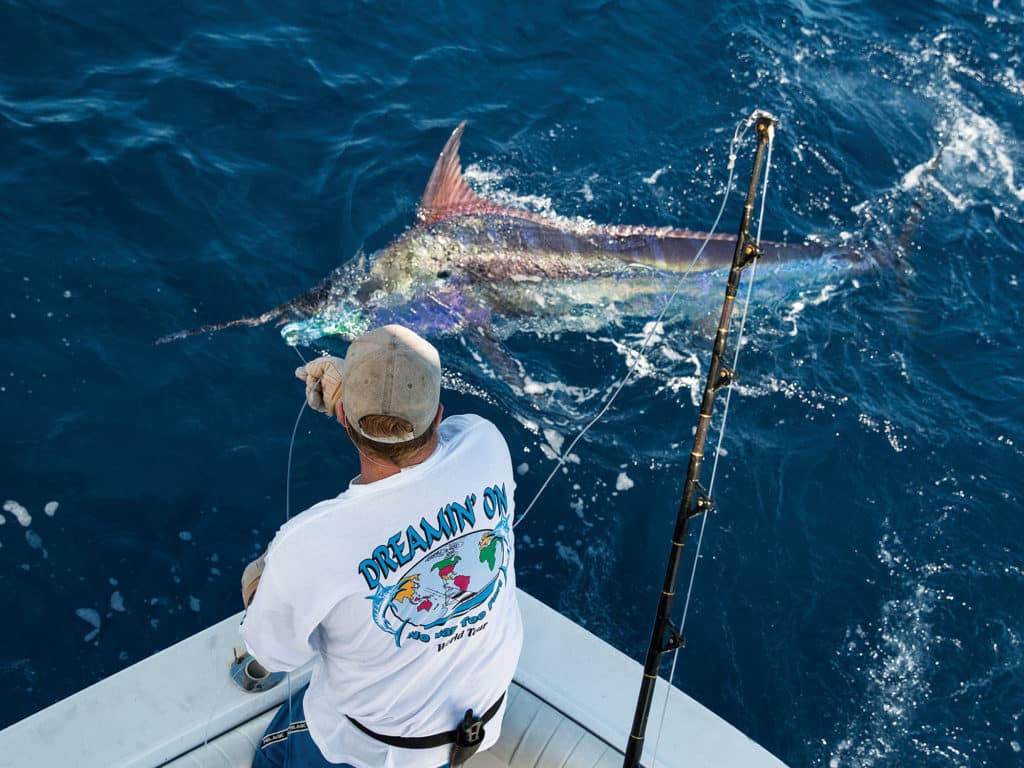
On the bridge, I will do my best to keep the boat behind the fish. If the fish goes deep, I will try not to end up in a situation where I am straight up and down on it; with that angle, there is no way I will know if I am pulling from behind the fish or in front of it. If the fish changes direction with the line straight up and down, the possibility of pulling the hook off the bill is high. Therefore, I try to keep a decent angle on the fish and show some patience to see if the fish will come up. The decision on what to do can be difficult to make. You can sit it out and hopefully catch the fish, or you can try some more aggressive moves to capture the fish more quickly, with a higher risk of pulling the hook simply so you can get lures back in the water and catch another fish. This is where a skipper’s quick judgment is put to the test, and you can quickly go from hero to zero and back to hero again in no time.
Scenario two: This is when a fish comes into the spread and eats the lure, and either sits there and turns to the sea, turns toward the white water or takes line and comes up dancing all over the ocean. When this happens, I am reasonably confident that this fish is hooked to some extent. I will once again play the fish the same way as I described earlier, and hopefully I will get an early shot at the fish. If, in this situation, the fish decides not to play the game and react to the drag change, I will get straight up and down on the fish, with the angler fighting the fish out to the side of the boat. I will start to do several hard turns on the fish and have the angler apply a lot of drag.
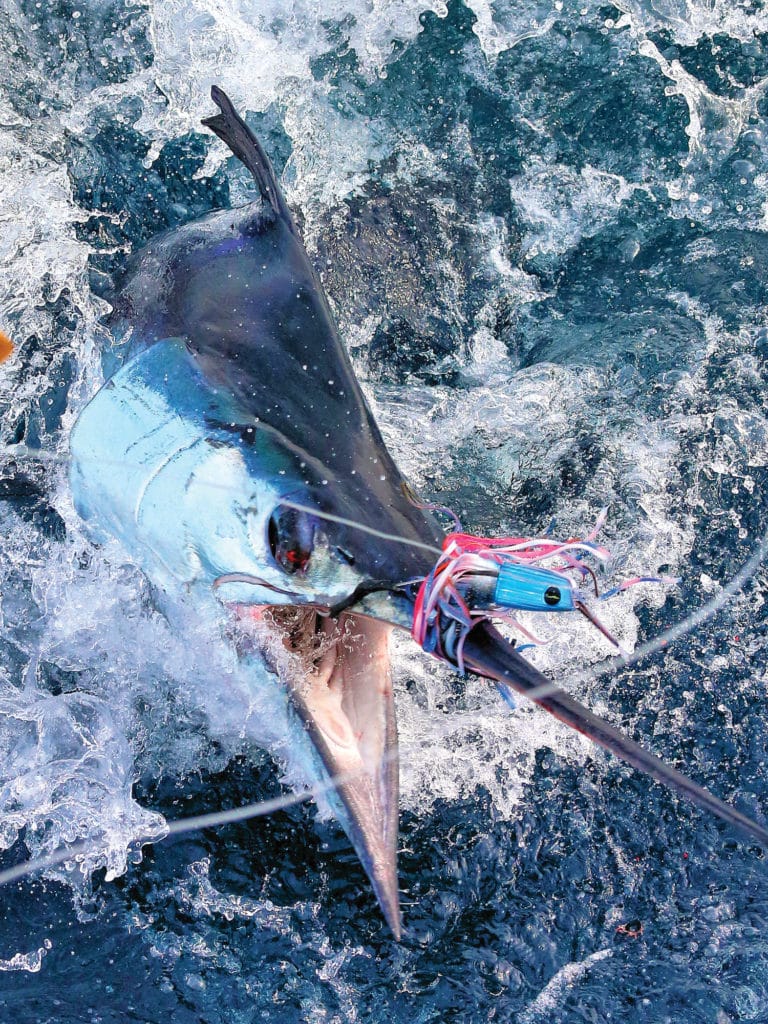
If the fish is not hooked in this situation, you will more than likely pull the hook off the bill. But if the fish is hooked, this is an absolutely deadly technique to raise a stubborn fish. By continuing to keep the boat on top of the fish the whole time and doing circles as you follow the line, the angler should be able to gain line as the fish allows it. You will find it normally takes only a couple of turns to get the fish to start coming up again. Not to mention, this is an extremely deadly technique to raise a stubborn tuna — you are matching the tuna’s circles and lifting the fish at the same time.
Scenario three: As the skipper, I frequently find myself having an excited angler who wants to apply a lot of drag on the fish when the fish is close to the boat. The angler will usually try to lift the swivel out of water so my crewman can get a shot at the leader, but this can be counterproductive. No matter how hard I chase the marlin with the boat, the fish will always be slightly out of reach. In this situation, I strongly encourage my angler not to wind tight on the fish, and I ask them to counterintuitively keep a belly from the rod tip to the swivel.
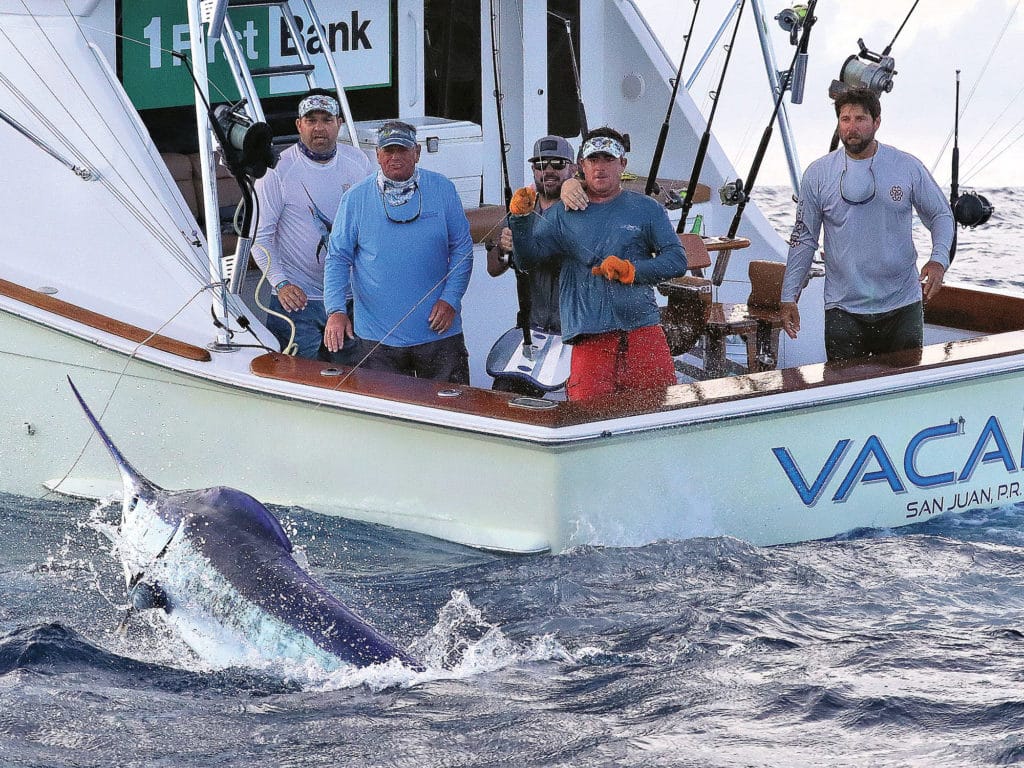
This will typically stop the fish from powering away and being just out of reach each time the angler pulls extra drag on the fish. This small change in angler behavior can be the difference between getting a shot at the leader or the fish sinking away, causing the angler to need to fight the fish for a much longer period of time. This not only wears out both the fish and angler, but you lose valuable time that you could use to put the lures back in the water and attract another marlin into the spread.
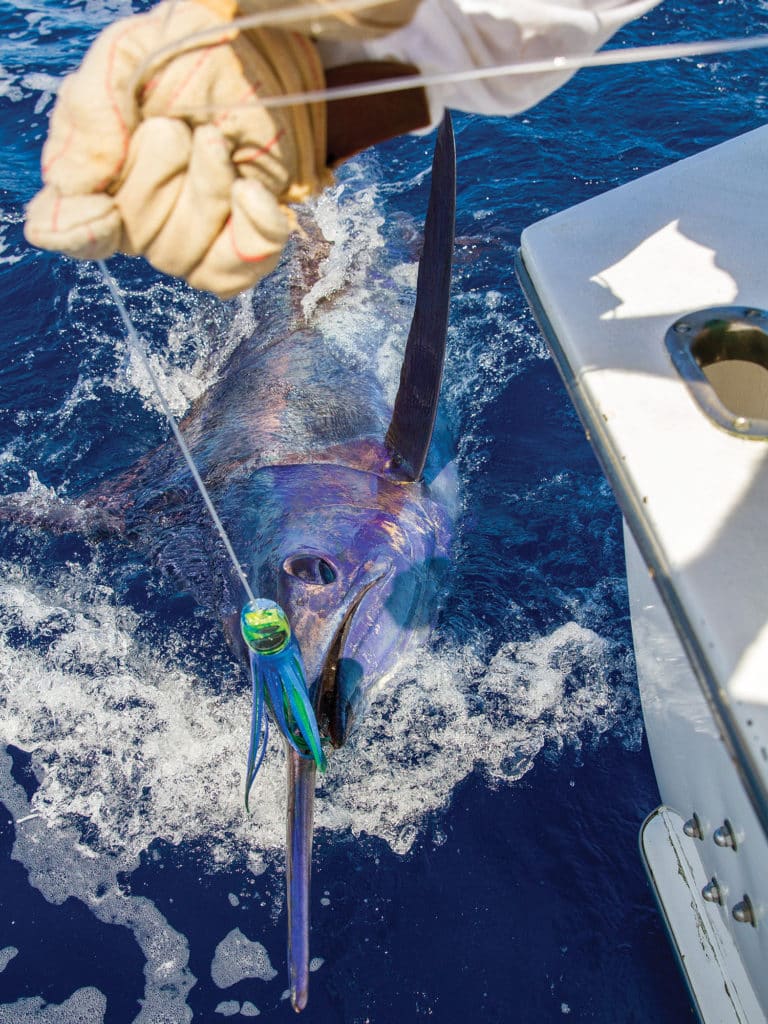
While these techniques have certainly improved my results in regard to the number of marlin I have caught, the meaningful part is how much more fun the experience has been for everyone involved. The fights are visual and close to the boat, which allows for fantastic video and photo opportunities for those on board. The angler learns about actual angling techniques, rather than simply winding on a fish and letting the boat do the work. The fight times are drastically reduced, which keeps both the angler and the fish in better condition. But what is most important is that the quick releases allow for more time with the lures in the water, which translates into more chances at an extra fish or two during the day.
